The Havens Family of East Donyland and Wivenhoe (1692-1924)
Philip Havens, General Practitioner and Surgeon of Wivenhoe and his family
Added by Pat Marsden
The Havens Family of East Donyland and Wivenhoe (1692-1924)
The Havens family were descended from a prosperous family of Colchester baymakers who manufactured a fine woollen felt like fabric. Since Philip was the traditional family name passed down from father to son their names have been numbered for the sake of clarity.
Philip 1 (1692-1769) Baymaker of Colchester
The first Philip Havens that we know of was the son of Robert Havens, the baymaker and his wife Elizabeth Talcott. He owned land and property at St Giles, Colchester, Little Wenham Hall and the farmhouse there called Hall Farm and he also acquired several additional properties in Gt. Wigborough, Salcott, Virleigh and Much Bromley as part of his marriage settlement to Anne Lowe (1702-1769). He was one of the prosperous Colchester Quakers who campaigned to regain Colchester’s lost Borough Charter in the mid eighteenth century. When Philip died in Tottenham in 1769, details of his Will (PROB 11/949 188) made 17 June 1967 and proved on 16 June 1769 describe him as a Bay maker of Colchester and the Chelmsford Chronicle 19 May 1769 also described him as a ‘very considerable manufacturer of baize’. They had four children: Ann (1722-1732), Elizabeth (1724-1728), Philip (1732-1778), Ann (1735-1815), and Robert (1736-?).
Philip 2 (1732-1778) Baymaker
Philip 2, the only surviving son, was the executor of his father’s will and received all the real estate including the ‘capital messuage’ where his father dwelt in the parish of St Giles, together with the workshop and millhouse and tenements to the north and south of the said dwelling. He also inherited a farm in Greenstead and two farms and a messuage at Capel and Little Wenham in Suffolk for life entailed to his male heirs. In 1768 he married Lucy Alefounder and they had five children: Philip (1768-1856), Anne (1770-?), Robert (1771-1818), Lucy (1772-1792), and William Upcher (1775-1784)..
Philip Havens 3 (1768-1856)
Merchant and Magistrate
It was Philip 3 who established the Wivenhoe connection. He was the eldest surviving son of Philip 2, born at St Giles in Colchester on 27 November 1768. He was educated at Cambridge, being admitted to Corpus Christi College as a pensioner on 20 June 1786 and was awarded the degree of LL.B. in 1794 [Alumni Cantabrigiensis] being described as ‘of Donyland Hall’ which he had purchased in the same year from Nicholas Caesar Corsellis who held a mortgage interest in the Manor. [East Donyland: Introduction’, A History of the County of Essex: Volume 10: Lexden Hundred (Part) including Dedham, Earls Colne and Wivenhoe (2001), pp. 186-191.]
On 6 October 1796 he married Mary Ann Sage (1774/5-1822) the eldest daughter of the linen draper Edward Sage, at St Mary the Virgin, Wivenhoe, by license [Gentleman’s Magazine vol 66 p1879 Marriages of remarkable Persons]. It may be that the families had been drawn together by their trade connections. Edward Sage was also prosperous and had purchased what was to become known as the Wivenhoe House Estate following the decease of Captain Daniel Harvey in 1794. When Edward Sage made his Will he appointed his son in law Philip as co executor with his wife Sarah Sage and left them various properties. Philip 3 was described as a Merchant and County Magistrate. He was J.P. for Essex and the borough of Colchester. On 12 May 1812, Philip was appointed Deputy Lieutenant of the Cinque Port of Sandwich (London Gazette 11 July 1812 p1346). He had six children: Mary Anne (1798-1840), Alicia (1800-1816), Elizabeth (1802-?), Philip (1805-1874) William Rawdon (1806-1887), and Henrietta Cordelia (1813/14-1862).
His wife died on 14 August 1822 at Donyland Hall, aged 47, and is buried in East Donyland, Essex [The New Monthly Magazine October 1822 p477]. There is a plaque in Mary Anne’s memory in Rowhedge church.
Whites Directory for Essex 1848 describing East Donyland as a small village, 3 miles S.S.E. of Colchester, states that ‘Philip Havens, Esq., is now lord of the manor, and owner of most of the soil. He resides at the Hall, a neat mansion, with woody pleasure grounds, near the confluence of the small river Roman with the Colne. The Hall and gardens were much improved about 1735, by Daniel Gausel, Esq., who enclosed the park.’ It also said that in 1794 the house contained four parlours and a drawing room or ballroom 38 ft. by 21 ft. on the ground floor, nine bedrooms on the first floor, and servants’ quarters in the attic.
In his Will dated 4 November 1844 Philip Havens 3 had made it clear that he was releasing his East Donyland estate to his eldest son Philip 4 on the understanding that a payment of one thousand two hundred pounds would be paid by Philip 4 to his sister Elizabeth and her husband Edward Brett after his death. A further payment of two thousand and eight hundred pounds should be paid unto his daughter Henrietta Cordelia Havens with a further annual sum of fifty pounds for her life, provided she should continue single and not have married.
His sons Philip Havens 4 and William Rawdon Havens were appointed executors of that will which was proved at the Prerogative Court of Canterbury (PROB 11/2248/243) on 19 March 1857.
Philip Havens 4 (1805-1874)
General Practitioner and Surgeon
Philip 4 was born on 31 August 1805 at East Donyland and baptised on 1 November 1805. Like his father he was educated at Corpus Christi College, being admitted as a pensioner in 1823 and matriculating in 1825 [Alumni Cantabrigiensis]
Philip was then apprenticed to John Grimes of Ramsey, Huntingdonshire as an apothecary for 5 years and admitted as a Licentiate of the Worshipful Society of Apothecaries (L.S.A.) on 28 Oct 1830 (Guildhall Library MS 8241/5 p383). He attended the London Hospital for twelve months and was admitted as a Member of the Royal College of Surgeons (M.R.C.S.) on 24 Dec 1830.
He married Elizabeth Elsworthy, born in Colchester (1817-1885), the daughter of Judith Elsworthy. They had eight children: Philip Havens (1846-1869), Emmaretta Havens (1849-1877), William Havens (1850-1920), Robert Havens (1853-1897), Edward John Havens (1855-1917), Harry Havens (1857-1919) Rawdon Havens (1859-1935), and Hugh Havens (1860-1904).
His work as a medical practitioner was frequently reported in the local press, the Essex Standard e.g. ‘Coroner’s Inquest at Wivenhoe’ in the 19.1.1849 edition and ‘Accident at Wivenhoe’ in the 9.5.1860 edition shown in the images to the right.
Philip 4 must have acquired or rented property in Wivenhoe by the 1830s as the 1838 Tithe Award Map refers to several parcels of land (300, 312, 313, 324, and 327) owned either by Mary Higginbottom (300 and 312) or Benjamin Smith (313, 324 and 327), which were occupied by Philip Havens. These were located to the East of the High Street running down from what would later become Queens Road towards East Street, abutting on the Falcon and the Church (see image to the right). In the 1851 Census it states that Philip 4 (aged 45) listed as a doctor, was living in East Street, Wivenhoe with his widowed father, Philip 3 (aged 82) listed as a County Magistrate; there were also three servants: a groom, a cook, and an upper servant. In the same Census Philip 4’s mother-in-law, Judith Elsworthy (described as a widower, aged 69) is listed with her daughter Elizabeth (Philip 4’s wife, aged 32) at Bath Street with three of their children, Philip 5 aged 4, Emmaretta aged 2, and William, aged 6 months (the two latter children being born in Wivenhoe).
However following the death of Philip 3 in 1856 advertisements began to appear in the local press (see images to the right) itemising the ‘surgery and fittings’ and stating that it had ‘for half a century been occupied by medical men’. The sale may have been precipitated by the imminent arrival of the Wivenhoe to Brightlingsea railway which was intended to run from Wivenhor Station under the High Street via a tunnel and crossing Philip Havens garden.
By 1861 the Havens family had moved to West Street. They are listed in the 1861 Census (Schedule 49) as Philip Havens, General Practitioner MRCS & FSA, aged 55, Elizabeth, his wife, aged 38, Emmaretta aged 11, scholar, William, aged 10, scholar, Robert, aged 7, scholar, Edward, aged 5, scholar, Harry, aged 3, Rawdon, aged 2, and Hugh, aged 5 months. His wife’s mother Judith, aged 83, was also present as a visitor, plus three servants: a coachman, a nurse and a cook.
On 25 April 1866 Philip 4 (Esquire) acquired a considerable amount of new property in Wivenhoe from Mssrs Edward Parkes and William Moseley Tabrum. This included:
a) a ‘messuage or tenement formerly divided into several tenements rentaries parcel of a messuage formerly called Old Hall with the yards gardens outhouses hereditaments and appurtenances thereunto belonging situate lying and being in Wivenhoe in the County of Essex’;
b) a ‘messuage or tenement being part of the Estate called the Undersett to the Cross Keys Tavern otherwise Rogers and Saxabies abutting East upon a messuage formerly of Mary Barker and West upon a messuage formerly of Thomas Clarke situate in Wivenhoe aforesaid’;
c) a ‘messuage or tenement with the yards gardens hereditaments and appurtenances there unto belonging now or heretofore called Cold Hall also situate and being in Wivenhoe aforesaid as all the said messuages or tenements hereditaments and premises were formerly part of the Estate of John Thomas and were formerly in the tenure or occupation of John Thomas his tenants or assigns then of Augustus Leneve [possibly Augustus le Neve?] then Abraham Ham David Durrell John Woodward Thomas Cole and William Powell then of the said Robert Wayland Tabrum and James Parkes their undertenants or assigns and are now or late were in the tenure or occupation of the said Edward Parkes and William Moseley Tabrum’.
d) ‘All that customary messuage or tenement … abutting upon the Church Yard there formerly in the occupation of Rebecca Durrell Widow or her assigns and heretofore called the Little Storehouse or otherwise holden of the said Manor by Copy of Court Roll …To the Use of the said Emmaretta Havens [his unmarried daughter 1849-1877] her heirs and assigns’. It was made clear in the Conveyance that ‘Philip Havens in consideration of his natural love and affection for his daughter the said Emmaretta Havens and in order to make some provision for her is desirous and hath determined that the said copyhold hereditaments shall be surrendered to the use of the said Emmaretta Havens her heirs and assigns’.
He was still listed as living in West Street in the census records of 1861-1871 but it may be that in his later years he relocated to East Donyland Hall which he had inherited following his father’s death.
He was certainly living at Donyland Hall when his death, at the age of 69, was reported on the 13th October 1874, and he was buried in the church of St Lawrence on 20 October 1874. His will dated 15 September 1874, was proved on 19 May 1875 (P.C.C.)
Edward John Havens (1855-1917)
it was left to Philip Haven’s wife, Elizabeth Elsworthy Havens, to settle his estate and pay off various accrued debts and mortgages. The natural successor to Philip 4 was his son Philip Havens 5 (1847-1869) but he died in his early twenties. The surviving four sons were: Edward John Havens of Witham, Surgeon, Harry Havens of East Donyland, Farmer, Rawdon Havens of Homington Brewery, Burton in Trent, Staffordshire, Brewer, and Hugh Havens of 18 Goldhanger Rd, Shepherd’s Bush in Middlesex, Brewer. When Elizabeth died on 6 April 1885 it was noted that there were still outstanding debts which the brothers were desirous of paying off. However in order to do this they took out yet another mortgage on the East Donyland Estate. It was eventually Edward John who took over custody of the Estate. He was not the oldest son but an agreement was drawn up between the brothers and he took up residence at Donyland Hall. Like his father he had trained as a surgeon and was cited in the Epsom Register as M.R.C.S and L.S.A. 1879 (Lond. Hosp.). (Travelling). On 6 November 1884 at the age of 29 he married Constance Louisa Jennings. Unfortunately the marriage soon started going downhill. In September 1898 [Morning Post 20.9.1898] he created a national scandal when he was accused of attempting to murder his twelve year old daughter Agnes Emmaretta Constance (1885-1945) by drowning her at Harwich Quay. This must have been the last straw and by October of the same year Caroline had obtained a separation order after years of physical and mental abuse and even imprisonment by her husband. She was given custody of her youngest child, Madge Hendrie (1887 -1955). From this point on Edward John fell into a state of repeatedly reported drunk and disorderly behaviour. In 1907 he attended a disciplinary hearing by the General Medical Council in which he said he had not been practising as a medical doctor for 15 years [Supplement to the British Medical Journal 30 November 1907, pp 310-11). According to the 1911 Census (now aged 55) he was living with his daughter Agnes Emmaretta Constance (aged 21) in a modest house on the corner of Chapel Road and the High Street (No 65 High Street) in Wivenhoe, which later became a grocer’s shop, a delicatessen and a much loved clothes and accessories shop called Talismans in the 1970s. In 1917 he died after an unfortunate altercation with the War Office (see image to right) and his widow, Mrs Caroline Louisa Constance Havens, disposed of this and the remaining property they owned in Wivenhoe in the lower end of the High Street and the corner of East Street and on East Street itself (see below).
Sources
D’Cruze, Shani, Colchester People: the John Bensusan-Butt Biographical Dictionary of Colchester, Vol 1 (A-L), p275-277, Lulu.com, 2009
Haven Family Deeds (1858-1895)

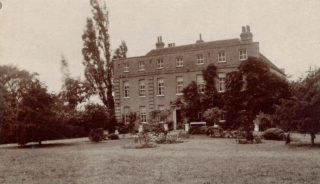





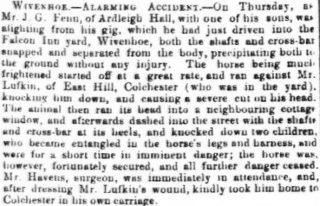
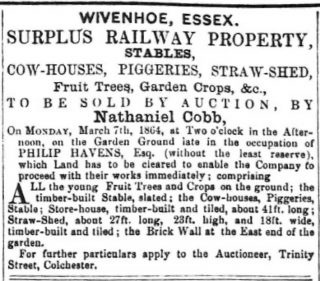
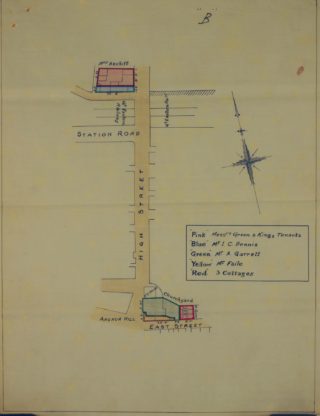
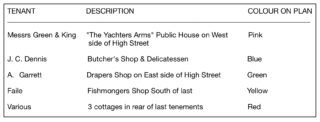
![BD3D63DF-324E-4727-95B8-0D1EEA1E9C05 Death Notice of Dr Edward John Havens | Chelmsford Chronicle, Friday, 16 November 1917 [British Newspaper Archive]](https://www.wivenhoehistory.org.uk/wp-content/uploads/2020/09/BD3D63DF-324E-4727-95B8-0D1EEA1E9C05-320x393.jpeg)






No Comments
Add a comment about this page